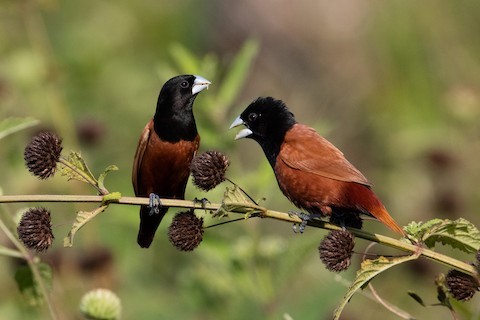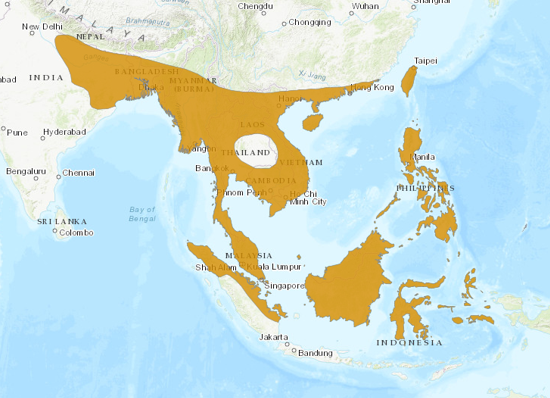Birdfinding.info ⇒ Uncommon and local across the continental portions of its range, but common in Taiwan, the Philippines, the Malay Peninsula (including Singapore), Sabah, and northern Sulawesi. In Thailand, it is locally common in marshes from Bangkok to Prachuap Khiri Khan, and in a few interior wetland areas. Also common in Hawaii, where it is often found in open grassy areas, including suburban lawns, on Kauai, Oahu, and Maui.
Chestnut Munia
Lonchura atricapilla
Southern Asia from India to Taiwan, the Philippines, and Indonesia. Introduced to several islands in the tropical Pacific.
Inhabits marshes, wet grassy areas, rice fields, and gardens from eastern India eastward to southern China and south through Indochina, Taiwan, the Philippines, Sumatra, Borneo, Sulawesi, and the Moluccas.
In India, it formerly occurred west to Haryana and northern Rajasthan, but the Tricolored Munia has largely displaced it from northern India and Nepal such that it is now scarce or absent west of West Bengal.
Introduced populations are established on Okinawa, Palau, Vanuatu, and Hawaii (Kauai, Oahu, Maui, and the Big Island), and locally in northwestern South America (western Ecuador and the Cauca Valley of Colombia) and coastal Portugal around Lisbon. Additional introduced populations have been reported from the West Indies, but they do not appear to be well established.
“Brown-headed Munia” (L. a. brunneiceps) is a distinct form that occurs on the southwestern peninsula of Sulawesi and some smaller islands to the east: Kabaena, Muna, Buton, Buru, and reportedly also on the Togian and Banggai Islands (east of central Sulawesi).
Identification
A medium-sized munia with a very large, pale blue or whitish bill, mostly chestnut-colored body, and a hood that is typically black but can be brown.
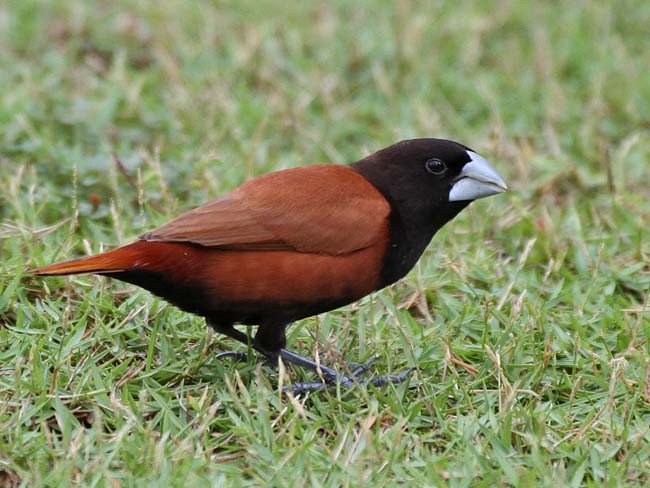
Chestnut Munia, L. a. jagori, showing a blackish belly patch with a blurred border. (Kota Kinabalu, Sabah, Borneo, Malaysia; May 1, 2014.) © Cherry Wong
There are noticeable color differences among and within populations: some are bright chestnut overall, some are browner or darker shades of chestnut, and some are much paler brown or rich rufous-chestnut.
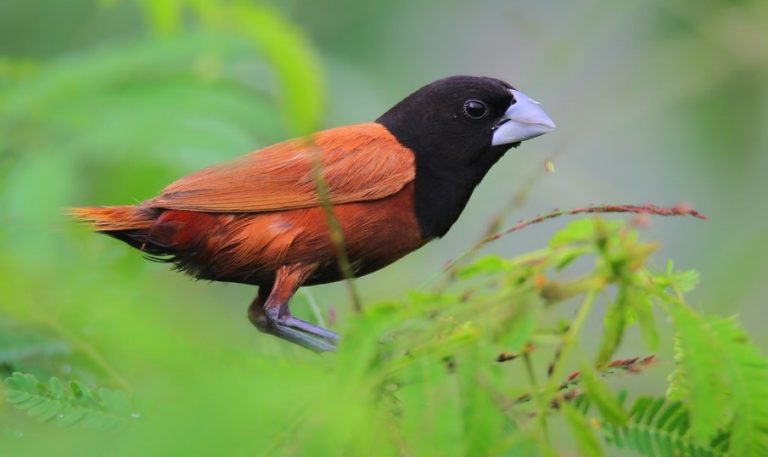
Chestnut Munia, L. a. sinensis, showing dark, but not black, belly. (Ban Bang Pu, Samut Prakan, Thailand; August 17, 2014.) © Apisit Wilaijit
The belly coloration varies across a wide spectrum: some are extensively black with crisp contrast, some show a gradation from chestnut to blackish, and some are entirely brown or chestnut.

Chestnut Munia, L. a. sinensis, showing a blurry-edged blackish belly patch. (Amphoe Ban Laem, Phetchaburi, Thailand; March 4, 2018.) © Luke Seitz

Chestnut Munia, L. a. atricapilla, a dark chestnut individual with a well-defined black belly patch. (Jorhat, Assam, India; June 4, 2011.) © Raj Kamal Phukan
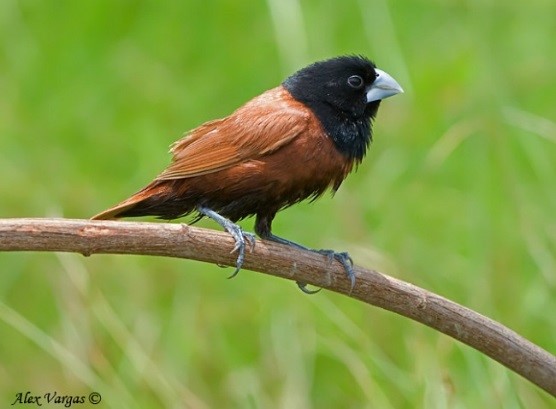
Chestnut Munia, identified as L. a. deignani, showing a blurry-edged blackish belly patch. (Bang Poo, Bangkok, Thailand; July 8, 2012.) © Alex Vargas
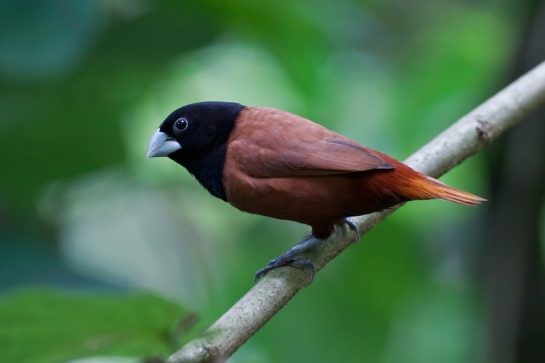
Chestnut Munia, L. a. sinensis, showing an all-chestnut belly. (Jurong Bird Park, Singapore.) © Darren Bellerby

Chestnut Munia, L. a. sinensis, showing an all-chestnut belly. (Batu Gajah, Perak, Malaysia; January 10, 2018.) © Zhong Ying Koay
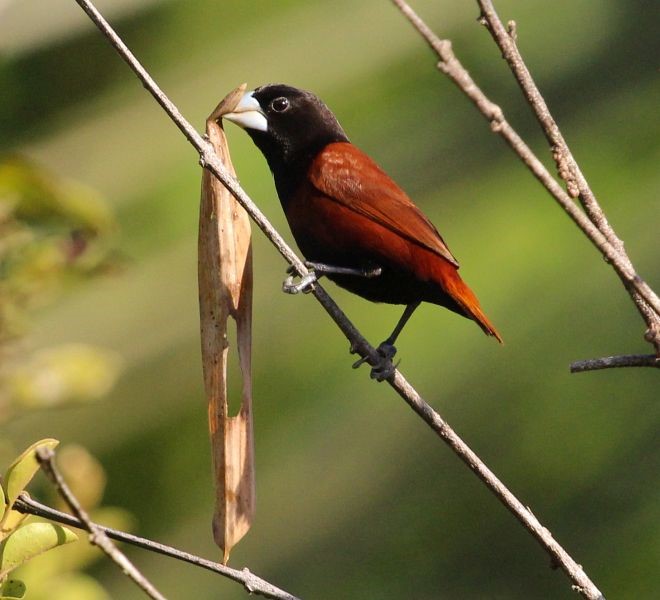
Chestnut Munia, L. a. jagori, showing a shadowed, blurry-edged, blackish belly. (Poring Hot Springs, Sabah, Borneo, Malaysia; July 4, 2016.) © Luis Mario Arce
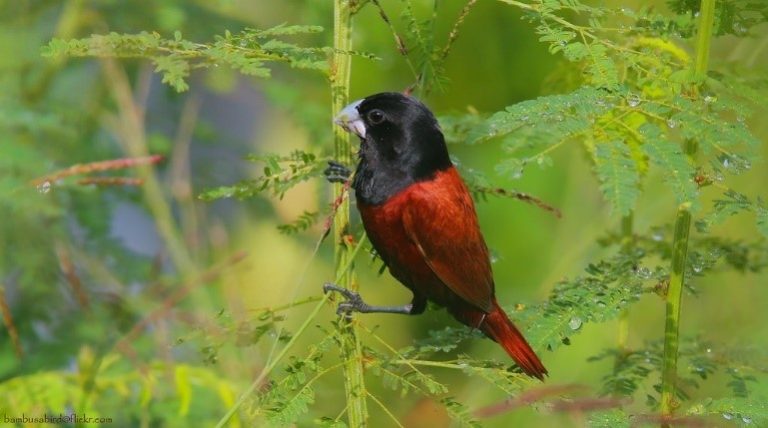
Chestnut Munia, L. a. sinensis, an unusually reddish individual with concolor rump and tail. (Ban Bang Pu, Samut Prakan, Thailand; August 16, 2014.) © Apisit Wilaijit
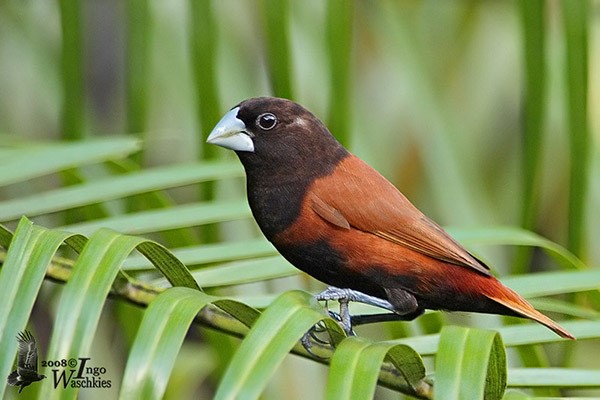
Chestnut Munia, L. a. jagori, with a blackish-brown hood and extensive but irregular black belly patch. (Palu, Sulawesi, Indonesia; August 24, 2008.) © Ingo Waschkies
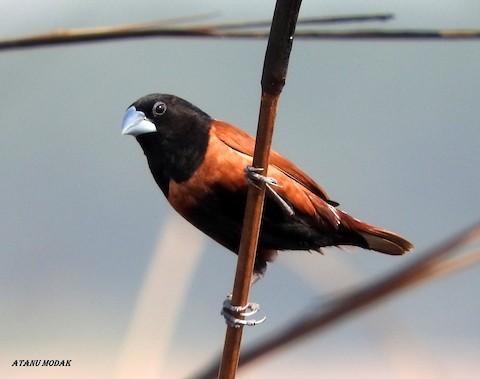
Chestnut Munia, L. a. atricapilla, ventral view showing a well-defined black belly patch. (Bosipota, Hooghly, West Bengal, India; December 30, 2018.) © Atanu Modak

Chestnut Munia, L. a. atricapilla. (Barasat, West Bengal, India; May 8, 2016.) © Subrato Sanyal
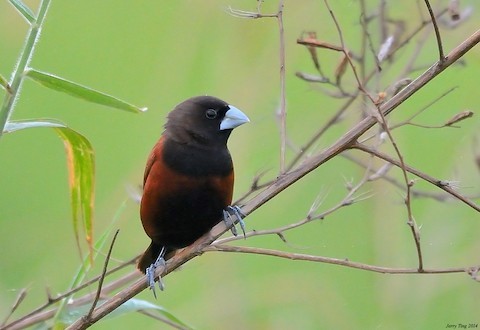
Chestnut Munia, L. a. formosana, showing an extensive, blurry-edged black belly patch. (Hualien, Taiwan; February 8, 2014.) © Jerry Ting
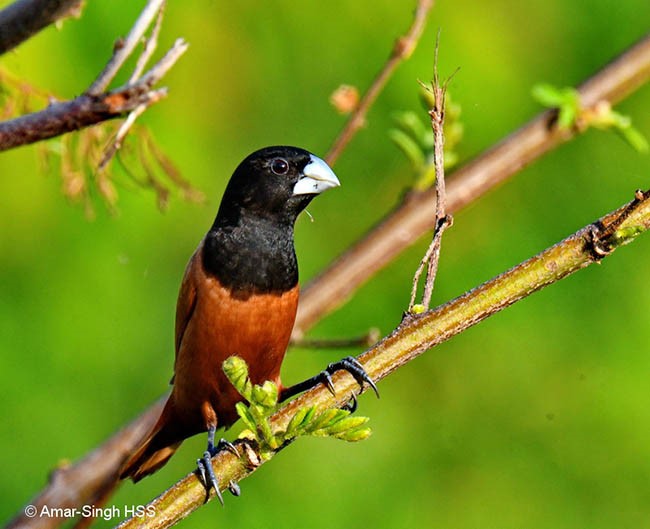
Chestnut Munia, L. a. sinensis, with rufous-chestnut belly. (Malim Nawar Wetlands, Perak, Malaysia; January 2, 2019.) © Amar-Singh HSS
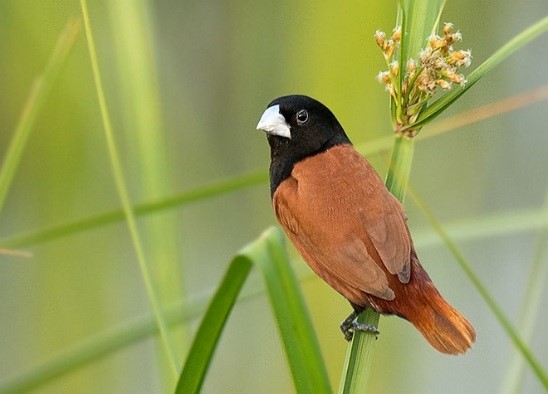
Chestnut Munia, L. a. atricapilla—note darker, rustier rump and paler, more orange tail. (Pobitora Wildlife Sanctuary, Assam, India; May 6, 2015.) © Ashok Kumar Das
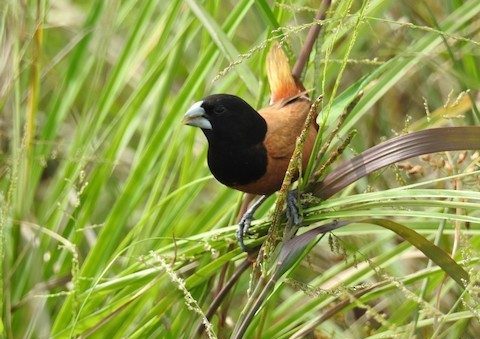
Chestnut Munia, L. a. sinensis, a pale-brown individual—note rustier rump and bright orange tail. (Batu Kawan Marsh, Pulau Pinang, Malaysia; May 15, 2019.) © Andy Lee

Chestnut Munia, L. a. atricapilla—note darker, rufous-chestnut rump and pale highlights in tail. (Guwahati, Assam, India; April 15, 2015.) © Raj Kamal Phukan
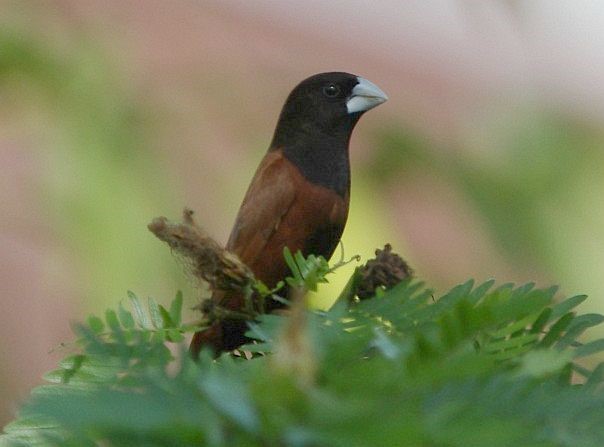
Chestnut Munia, L. a. jagori, a dark-brown individual with a blurry-edged blackish belly. (Tambun, Sulawesi, Indonesia; September 8, 2005.) © David and Nancy Massie
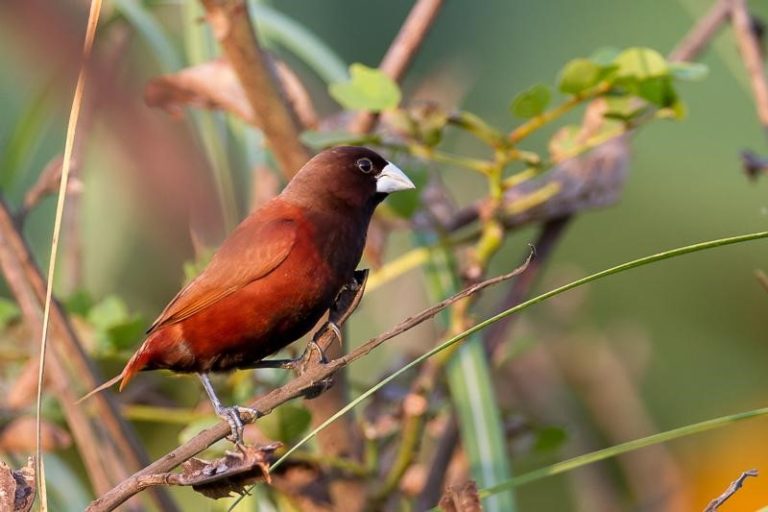
Chestnut Munia, L. a. formosana, with a brown hood and blurry-edged blackish belly patch. (Luzon, Philippines; April 2, 2013.) © Paul van Giersbergen
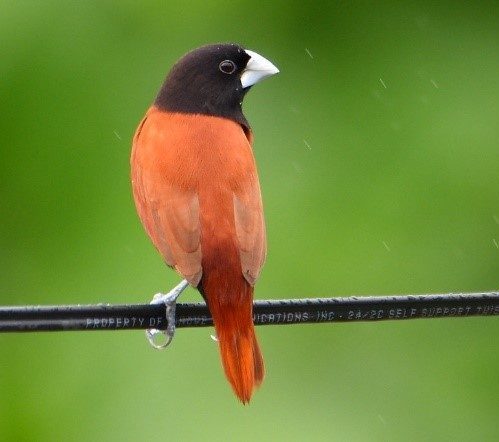
Chestnut Munia, L. a. jagori, with darker rufous-chestnut rump and bright orange tail. (Dumaguete, Negros Oriental, Philippines; January 2, 2018.) © Chris Chafer
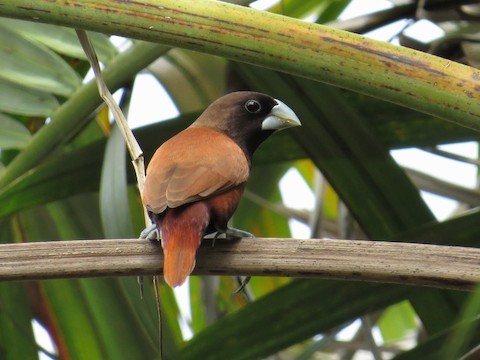
Chestnut Munia, L. a. formosana, with brown hood and pale tail. (Paranaque City, Manila, Philippines; January 20, 2018.) © George Inocencio

Chestnut Munia, L. a. formosana, with brown hood, rufous-chestnut rump and light-orange tail. (Honolulu, Hawaii; June 5, 2019.) © Tony Iwane
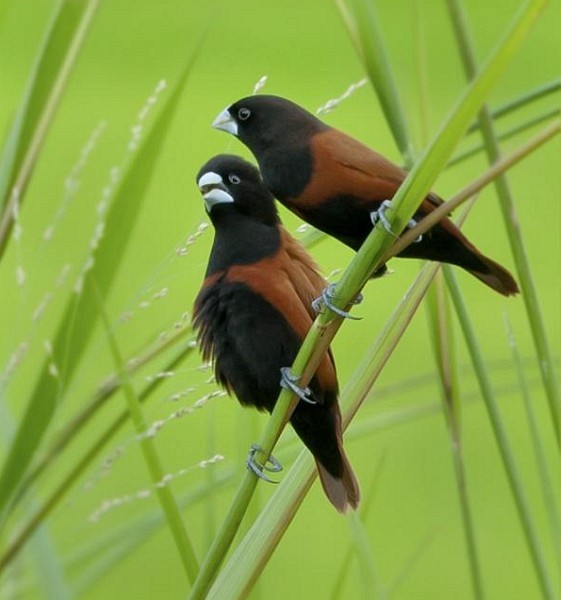
Chestnut Munia, L. a. jagori, with extensive, well-defined black belly patch. (Penampang, Sabah, Borneo, Malaysia; January 13, 2013.) © Sarah Lim
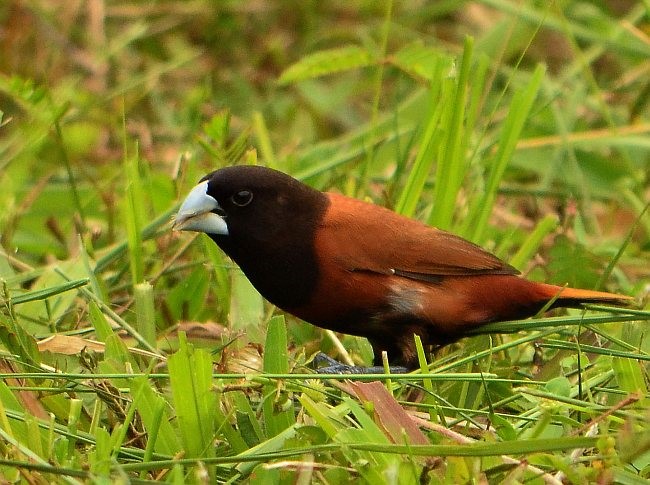
Chestnut Munia, L. a. jagori, with blurry-edged blackish belly patch. (Sam Ratulangi University, Manado, Sulawesi, Indonesia; June 21, 2012.) © Arief Rahman
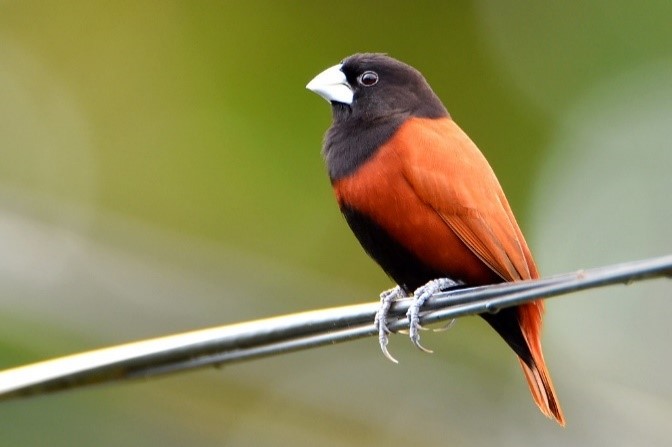
Chestnut Munia, L. a. jagori. (Dumaguete, Negros Oriental, Philippines; January 2, 2018.) © Chris Chafer
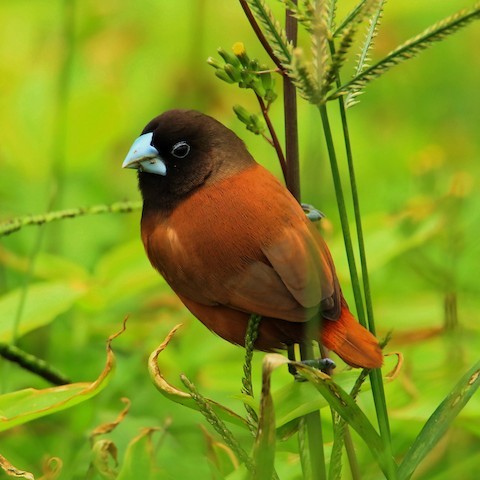
Chestnut Munia, L. a. formosana, with a brown hood—note bright rusty tail. (Huajiang Wild Duck Nature Park, Taipei, Taiwan; February 3, 2016.) © Poshien Chien

Chestnut Munia, L. a. formosana, with a brownish hood and blurry-edged blackish belly patch —note light-orange tail. (Honolulu, Hawaii; October 25, 2018.) © Kellen Apuna
“Brown-headed Munia” (L. a. brunneiceps) reportedly overlaps with L. a. jagori on southern Sulawesi without known interbreeding and has different vocalizations, so it may prove to be a separate species. It has a medium- to pale-brown hood, blackish belly, most resembling the brownest individuals of L. a. formosana, which does not occur with it.
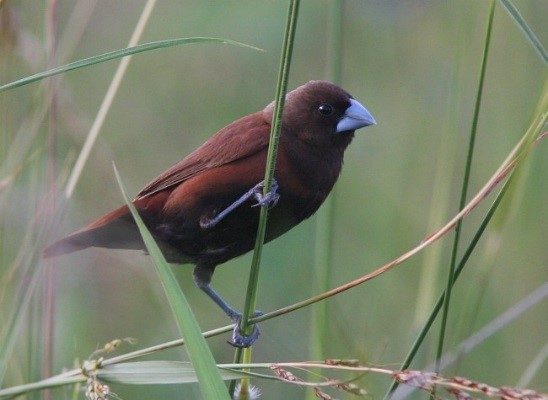
“Brown-headed Munia,” L. a. brunneiceps. (Namlea, Buru, Indonesia; January 27, 2011.) © Michael K. Poulsen
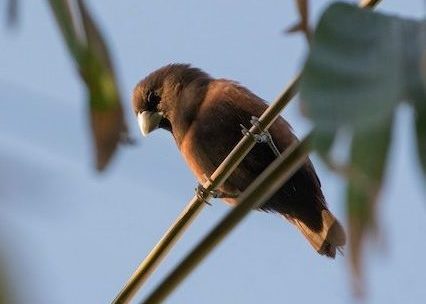
“Brown-headed Munia,” L. a. brunneiceps. (Fort Rotterdam, Selatan, Sulawesi; September 17, 2017.) © Bill Bacon
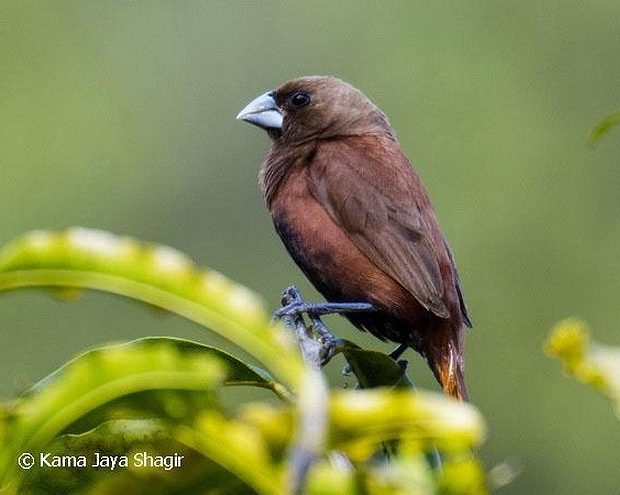
“Brown-headed Munia,” L. a. brunneiceps. (Bantimurung Bulusaraung National Park, Sulawesi, Indonesia; July 21, 2016.) © Kama Jaya Shagir

“Brown-headed Munia,” L. a. brunneiceps. (Namlea, Buru, Indonesia; January 27, 2011.) © Michael K. Poulsen
Immature plumages are similar to those of several other munias, warm-brown above and buffy below, some rustier and some more neutral brown. Many individuals show a slightly darker hood that is limited to the head and neck.
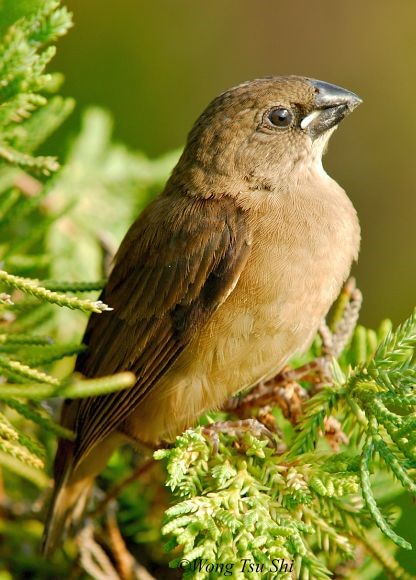
Chestnut Munia, L. a. jagori, immature. (Tawau, Sabah, Borneo, Malaysia; September 6, 2006.) © Wong Tsu Shi

Chestnut Munia, L. a. atricapilla, immature. (Hurijala, Melaghar, Sepahijala District, Tripura, India; October 19, 2018.) © Manish Kumar

Chestnut Munia, L. a. formosana, immature beginning to molt into adult plumage. (Honolulu, Hawaii; June 17, 2018.) © Sharif Uddin

“Brown-headed Munia,” L. a. brunneiceps, immature. (Fort Rotterdam, Selatan, Sulawesi; September 17, 2017.) © Bill Bacon

Chestnut Munia, L. a. atricapilla, immature. (Manas National Park, Assam, India; November 13, 2016.) © Anwaruddin Choudhury
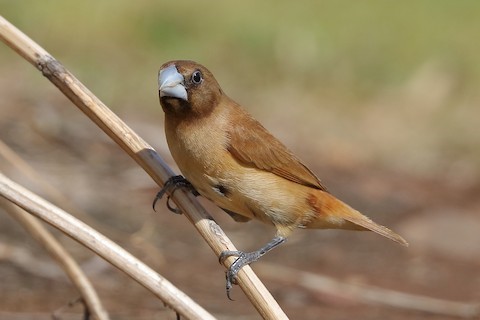
Chestnut Munia, L. a. formosana, immature. (Honolulu, Hawaii; August 18, 2017.) © Sharif Uddin

Chestnut Munia, L. a. formosana, immature. (Koror, Palau; June 18, 2019.) © Lin Scott
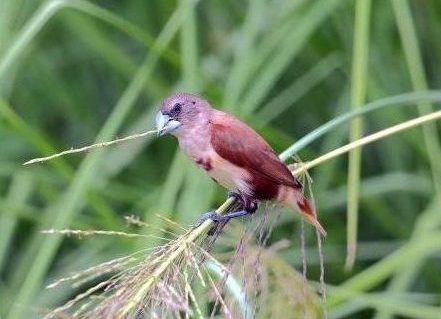
Chestnut Munia, L. a. sinensis, immature molting into adult plumage. (Laem Pak Bia-Pak Thale, Phetchaburi, Thailand; August 9, 2015.) © bird.soong

Chestnut Munia, L. a. jagori, juvenile. (Makassar, Sulawesi, Indonesia; May 4, 2005.) © Wong Tsu Shi
Cf. Tricolored Munia. Some variants of Tricolored Munia are very similar to some Chestnut Munias. They occur together in West Bengal, western Bangladesh, formerly and perhaps still westward on the Ganges River plain in northern India and Nepal (where Tricolored has apparently displaced Chestnut), in northwestern South America (western Ecuador and Colombia), and possibly on some Caribbean islands—though most if not all recently documented records from the West Indies appear to be Tricolored.
Both species vary but in different ways, and an understanding of their variations enables reliable identification of the vast majority of apparently intermediate individuals. In such cases the key features are the belly pattern and coloration of the flanks.
In general: (1) Tricolored has a specific belly pattern that is nearly invariable, whereas Chestnut’s belly pattern is highly variable; and (2) Chestnut’s flanks and upperparts are almost always concolor, or nearly so, whereas Tricolored almost always has flanks that are distinctly paler than its upperparts.
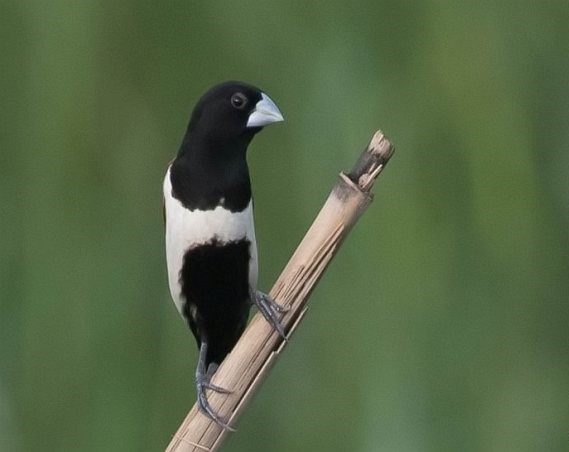
Tricolored Munia, showing its characteristic underparts pattern and coloration. (Yamuna Khader, Wazirabad, Delhi, India; July 23, 2017.) © Rajesh Kalra
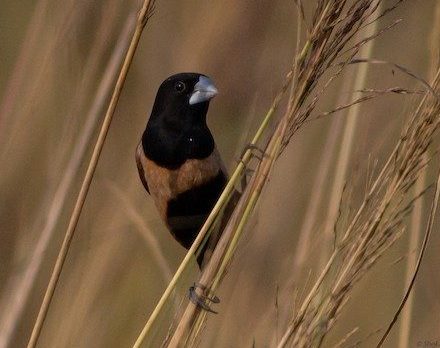
Tricolored Munia, showing its characteristic underparts pattern, but atypical coloration. (Rajarhat, North 24 Parganas, West Bengal, India; October 27, 2018.) © Shekar Vishvanath
Belly Pattern: Tricolored Munia consistently shows a crisply defined black belly. The rest of its underparts (i.e., the flanks, sides, and breastband) are typically white, but can also be any of a range of other colors including yellow, tan, cinnamon, rufous, and several shades in between. The width of the breastband is also consistent at about the same width as the bill (although posture can affect this appearance).
Chestnut Munia varies widely in belly color and pattern, both regionally and individually. In atricapilla, the subspecies that occurs naturally with Tricolored, very few individuals, if any, show the same belly pattern as Tricolored. Many have a black belly, but in most cases Chestnut’s belly patch is not crisply defined—instead it typically blurs from black to blackish to chestnut.
Note that some subspecies of Chestnut—mainly jagori of the Philippines and Indonesia—can show a crisply defined black belly, but the shape and extent of the patch usually differs and these subspecies rarely, if ever, overlap with Tricolored.

Chestnut Munia, L. a. jagori, a dark-brown individual with a characteristically blurry-edged blackish belly. (Tambun, Sulawesi, Indonesia; September 8, 2005.) © David and Nancy Massie

Chestnut Munia, L. a. formosana, with brown hood and blurry-edged blackish belly patch. (Luzon, Philippines; April 2, 2013.) © Paul van Giersbergen
In cases of potential confusion, a crisply defined black belly patch usually indicates Tricolored. When Chestnut shows a similarly well-defined belly patch (as in the photo below) it is often more extensive or otherwise different from Tricolored’s characteristic pattern.

Chestnut Munia, L. a. jagori—the belly patch is well-defined, but very extensive, making the breastband narrow—and this location is far out of Tricolored’s range. (Penampang, Sabah, Borneo, Malaysia; January 13, 2013.) © Sarah Lim
Flank Coloration: On Chestnut Munia, the flanks and upperparts are consistently concolor, within a few shades of each other. Most are chestnut or rufous, some are other shades of brown, but the flanks and upperparts match.
On Tricolored Munia, the flanks and upperparts rarely match. Instead, the upperparts are usually bright chestnut or another rusty shade of brown and the flanks are distinctly paler. (As noted above, the flanks are typically white but can be yellow, tan, cinnamon, rufous, and several shades in between.)

Chestnut Munia, L. a. atricapilla—note concolor flanks and underparts—the belly patch is well-defined, which suggests Tricolored, but it would be out of range. (Jorhat, Assam, India; June 4, 2011.) © Raj Kamal Phukan
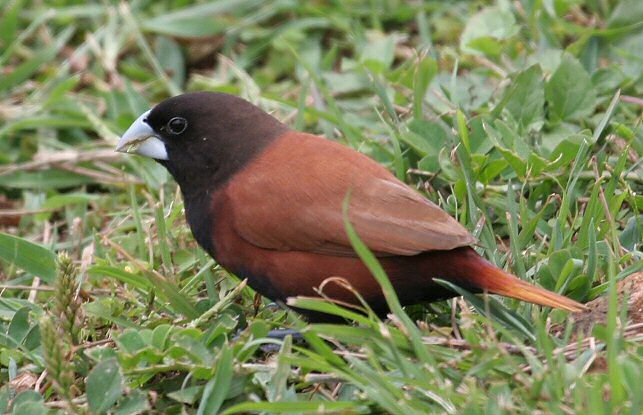
Chestnut Munia, L. a. formosana, showing characteristically concolor flanks and upperparts—this individual also has a brownish hood, which is rarely, if ever, seen on Tricolored. (Wailua, Kauai; April 6, 2005.) © William Hull
In cases of potential confusion, contrastingly pale flanks almost always indicates Tricolored, and a close match between the upperparts and the flanks almost always indicates Chestnut.

Tricolored Munia, cinnamon variant, showing characteristic contrast between upperparts and much paler flanks. (Barasat, North 24 Parganas, West Bengal, India; September 4, 2013.) © Subrato Sanyal
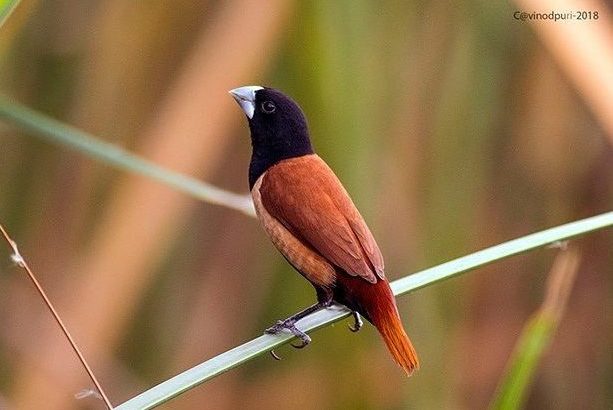
Tricolored Munia, unusual pinkish variant—note contrast between upperparts and much paler flanks. (Akheraj Swamp, Jodhpur, Rajasthan, India; August 5, 2018.) © Vinod Puri Goswami
Double Positives: In a few cases, a confusing Tricolored / Chestnut Munia has both a crisply defined black belly and a match or near-match between the upperparts and the flanks.
Some of these individuals may be hybrids, some may be naturally aberrant. In most such cases, other factors will tend to indicate one species over the other, but perhaps not definitively. (See examples below.)
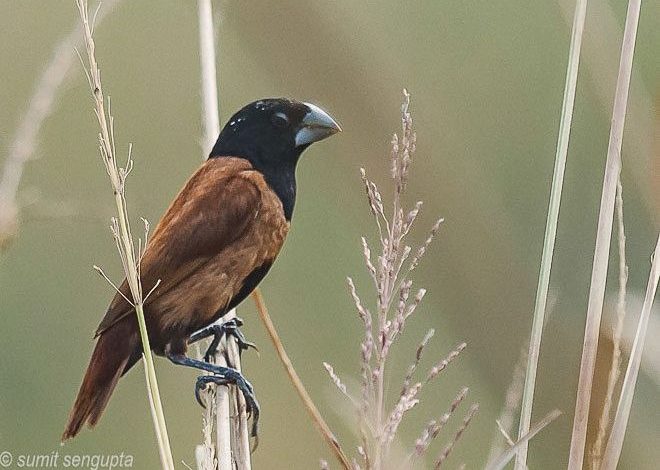
Tricolored Munia—likely, based on well-defined belly patch—in this photo, the flanks appear only slightly paler than the upperparts. (Baruipur, South 24 Parganas District, West Bengal, India; November 25, 2018.) © Sumit Sengupta

Chestnut Munia—likely, based on blurred belly pattern and concolor upperparts and flanks. This individual is unusually pale and was identified as a cinnamon morph Tricolored. (Esmeraldas, Ecuador; January 27, 2014.) © Nick Athanas

Chestnut Munia, L. a. atricapilla—likely, based on overall coloration and blurred belly patch. In this photo, the flanks appear somewhat paler than the upperparts, but part of this impression is due to strong lighting. (Bosipota, Hooghly, West Bengal, India; December 30, 2018.) © Atanu Modak
Notes
Polytypic species consisting of eight recognized subspecies, including the potentially distinct “Brown-headed Munia” (L. a. brunneiceps).
Often considered conspecific with Tricolored Munia, together comprising the Black-headed Munia (L. malacca), sometimes also including White-capped Munia, but the three are increasingly regarded as separate species.
Frontiers of Taxonomy: Tricolored and Chestnut Munias.
The relationship between Tricolored and Chestnut Munias (Lonchura malacca and L. atricapilla) has been fraught with confusion and some disagreement remains over their taxonomic status. The ornithological literature lumped them together as the Black-headed Munia (L. malacca) during most of the 1900s. Since the mid-1990s the trend has been to recognize them as separate, following Robin Restall, who wrote the most comprehensive reference work on munias worldwide (Munias and Mannikins, 1996). But several sources of confusion remain—most emanate from India, where both species (or forms) are native:
A portion of the Tricolored Munia population is variably intermediate in appearance. Most of these birds show the pattern of Tricolored but the coloration of Chestnut—and in some cases field identification is difficult. Individuals that fit this general description apparently occur to some extent throughout Tricolored’s range, but they may be more numerous in areas of potential overlap with Chestnut. Some of these intermediate birds may be hybrids (or back-cross descendants of hybrids) but most are merely color morphs of Tricolored.
Many authoritative references in India continue to treat Tricolored and Chestnut as a single species. Some add to the confusion by using the name Tricolored Munia to refer to the collective. As a result, many observers there do not attempt to differentiate between them in their field observations.
Tricolored Munia has apparently expanded its range north across a broad region of the Indian subcontinent (essentially throughout the Ganges River plain), and now occupies a large area that was formerly occupied by Chestnut Munia, apparently out-competing and replacing it. As a result, most references to the distributions of the two species do not reflect their current status.
Restall has argued for separating Tricolored and Chestnut Munias based on, among other factors, differences in vocalizations and the gape patterns of nestlings. As both species are often kept as cage birds, sometimes together in aviaries, Restall also cites the experience of aviculturalists who report that Tricolored and Chestnut self-segregate when given the opportunity. Assortative breeding has also been reported in the wild in both native and introduced populations.
In addition, the apparent displacement of Chestnut Munias by Tricolored along the Ganges is facial evidence that the two species do not simply blend into a common gene pool when they come into contact. Instead, it appears that one form out-competes and eliminates the other, which is consistent with their being different species that remain genetically intact and have divergent adaptive success.
The existence of apparently intermediate individuals is the original source of confusion over the status of Tricolored and Chestnut Munias, and it causes three persistent problems. First, it appears to be facial evidence of hybridization, which suggests that the two are a single species and therefore not reliably distinguishable, so few observers make the effort. Second, the intrinsic variation within both species is not well depicted in field guides, so there is no adequate reference to help observers reliably identify apparently intermediate individuals. Third, the lack of clarity leads to inconsistent field identification of those apparently intermediate individuals, so a large portion of observer reports are simply unreliable.
The field identification problem is best solved by a study of the intrinsic variation in both species. With this knowledge, most clearly observed individuals can be reliably identified. For an account of their variation and guidance on some consistent distinctions to differentiate them in the field, see above.
References
BirdLife International. 2018. Lonchura malacca. The IUCN Red List of Threatened Species 2018: e.T22719837A131885437. http://dx.doi.org/10.2305/IUCN.UK.2018-2.RLTS.T22719837A131885437.en. (Accessed July 12, 2019.)
Brazil, M. 2009. Birds of East Asia. Princeton University Press, Princeton, N.J.
eBird. 2019. eBird: An online database of bird distribution and abundance. Cornell Lab of Ornithology, Ithaca, N.Y. http://www.ebird.org. (Accessed July 12, 2019.)
Hawaii Audubon Society. 2005. Hawaii’s Birds (Sixth Edition). Island Heritage Publishing, Waipahu, Hawaii.
National Institute for Environmental Studies, Invasive Species of Japan, Lonchura atricapilla. https://www.nies.go.jp/biodiversity/invasive/DB/detail/20220e.html. (Accessed April 15, 2018.)
Payne, R. 2018. Chestnut Munia (Lonchura atricapilla). In Handbook of the Birds of the World Alive (J. del Hoyo, A. Elliott, J. Sargatal, D.A. Christie, and E. de Juana, eds.). Lynx Edicions, Barcelona. https://www.hbw.com/node/61195. (Accessed July 12, 2019.)
Pratt, H.D. 1993. Enjoying Birds in Hawaii: A Birdfinding Guide to the Fiftieth State (Second Edition). Mutual Publishing, Honolulu, Hawaii.
Pyle, R.L., and P. Pyle. 2017. The Birds of the Hawaiian Islands: Occurrence, History, Distribution, and Status. Version 2. B.P. Bishop Museum, Honolulu, Hawaii. http://hbs.bishopmuseum.org/birds/rlp-monograph/.
Raffaele, H., J. Wiley, O. Garrido, A. Keith, and J. Raffaele. 1998. A Guide to the Birds of the West Indies. Princeton University Press, Princeton, N.J.
Restall, R. 1996. Munias and Mannikins. Yale University Press, New Haven.
